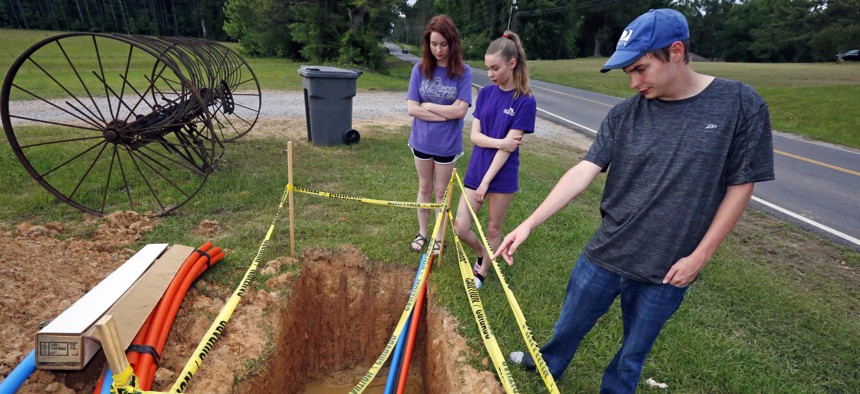Ensuring State Broadband Grants Go the Extra Mile

In this May 8, 2019, photograph, Riley Shaw, right, and his youngest sister, Leah, center, and his twin, Abigail, stand around a fiber-optic line that is expected to bring the Shaw family internet service to their home outside Starkville, Miss. AP Photo/Rogelio V. Solis
From grant matching to community engagement teams, officials who oversee state broadband grants say it’s important to require communities and companies that receive public funding to meet certain benchmarks.
A Virginia grant program that subsidizes the construction costs to expand rural broadband in the state has scaled up dramatically since it began. This year the state will have $19 million to offer compared to just $1 million in 2017.
But to get the money, Virginia’s Department of Housing and Community Development requires local governments and private internet service providers to co-submit grant applications, said Tamarah Holmes, the director of the department’s broadband.
“It’s actually written into our legislation that it’s a public-private partnership,” Holmes said of the match-making process.
As state governments have prioritized improving broadband infrastructure across the country, they’ve rapidly expanded grant funds like the popular Virginia Telecommunications Initiative. But to ensure the money is well spent, states are requiring grant applicants to meet certain requirements—like providing matching funds or establishing education campaigns to teach residents internet literacy skills.
Officials who oversee state broadband grant programs discussed these ideas for grant administration in Washington, D.C. during a Pew Charitable Trusts event this month. The officials said the need far outstrips the available funding and emphasized ways to get as much value out of each grant dollar as possible.
Holmes said her department in Virginia wants to be flexible in its grants, so it also solicits feedback from both public and private entities each year and has amended its grant guidelines annually based on those suggestions.
In Tennessee, which has awarded $45 million in broadband grants since 2017, private companies are required to match the grant amount they receive in order to double the impact of investments, said Crystal Ivey, the broadband director for the state’s Department of Economic and Community Development.
“That, right off the bat, is doubling the financial impact of the grant in these communities,” she said.
The state also reviews a series of other metrics to assess the potential impact of a grant before it is awarded. That could include an assessment of which communities an internet service provider could have reached with and without financial assistance from the state, or how the providers are going to encourage use of the service, Ivey said.
“That is a question we get often from stakeholders. The state is investing funds in this area, how are you ensuring that people are really maximizing the full benefit of this newly installed infrastructure?” she said. “We ask providers what are you going to do in the grant areas to encourage the usage of this infrastructure? Are you going to do your typical marketing or are you going to go beyond that?”
Examples of going above and beyond could include sponsoring internet literacy classes at local libraries or offering low-cost options for low-income residents, Ivey said.
The Federal Communications Commission approved a $20.4 billion plan last month to subsidize the construction of high-speed broadband networks in rural America. FCC Commissioner Geoffrey Starks raised concerns at the time that the order authorizing the Rural Digital Opportunity Fund included language that could exclude states from the program if they pay for their own rural broadband initiatives. The FCC later revised the order, saying its intent was to exclude areas from inclusion in the program if they are able to provide internet service above a certain speed without RDOF support, not to block use of multiple funding sources.
As state programs look to expand access to broadband, information about who is connected to the internet and who is not remains an issue. Connectivity data collected by the FCC often overestimates broadband’s reach, meanwhile the RDOP does not address those incorrect estimates.
This is why it is important for states to work with local leaders to understand their communities’ needs before moving ahead with broadband grants, said Peggy Schaffer, executive director of the ConnectME Authority in Maine. The authority, which is aiming for 95% broadband connectivity by 2025, offers communities and regional organizations grants for broadband planning and for last-mile infrastructure.
To be certified for a planning grant, a community must establish a community broadband team that includes at least one local government official, as well as members representing schools, local businesses and healthcare institutions, Schaffer said.
Building partnerships with local groups and requiring hyper-local engagement has ensured that planning groups know the needs of their community.
“It really has to be a bottom up, a grassroots effort. The state does not have the personnel resources or knowledge to impact this at the local level in the way local communities do,” Schaffer said. “Broadband connectivity happens at a street-by-street basis, it doesn’t happen at the state level.”
Andrea Noble is a staff correspondent with Route Fifty.
NEXT STORY: Victims of NIMBYism, Unite





